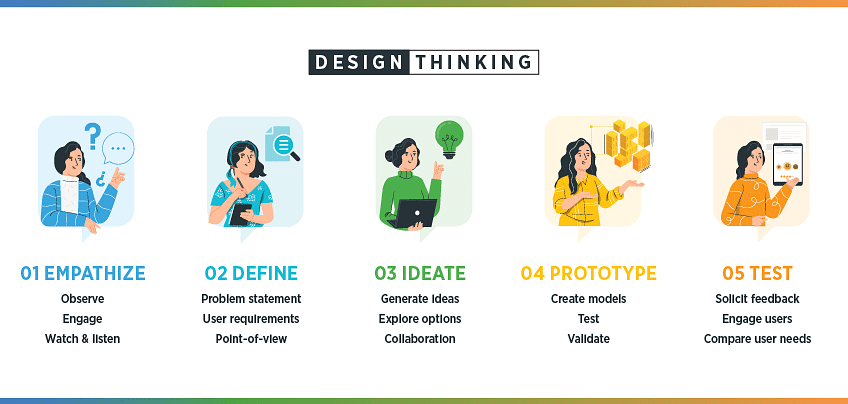The notion of becoming more “customer-focused” is now a critical business imperative for most ambitious companies. And as they drive for that extra competitive edge, design thinking is growing into an indispensable tool for developers and designers alike. The design thinking process is an iterative methodology that aims to understand end user behavior, challenge existing assumptions, and redefine problems to create solutions that may not be immediately apparent. It helps designers question fundamental assumptions and reframe a problem in a more human-centric way, and it drives more fundamentally user-friendly products.
As put forth in an overview by the Institute of Design at Stanford, there are five key steps in the popular design thinking process and framework:

Step 1: Empathize
The first under the design thinking process steps, empathy, is at the heart human-centered design, providing the initial jolt in understanding people within the context of a design challenge. In order to design for others, you must first gain empathy for what is most important to them in both physical and emotional ways. The expectations of today’s customers are as high as they’ve ever been, both for product usability and company brand. Designers must learn how users interact within their environment and gain insight into their personal experiences.
The empathize phase can be broken down into three categories:
- Observe: Watching user behavior in the context of their lives helps identify disconnects between what someone says and what they actually do, and it might surface some surprising insights.
- Engage: Similar to interviewing, engaging includes a personal conversation which should be loosely constructed so that you can elicit deeper information and uncover the “why” in your analysis.
- Watch and Listen: Designers must observe how a user completes a task, physically going through all the steps and explaining what they are doing at every juncture.
The next, under the design thinking process steps, is define.
Step 2: Define
Design thinkers must be able to define the challenge they are taking on based on what they learn about the user and context. The goal of the define stage is to create a meaningful and actionable problem statement that focuses on the needs of the user. This point of view (POV) defines the right problem you want to address based on the people and circumstances involved and helps synthesize findings into real insights.
A good POV frames the problem properly, creates perspectives from which to evaluate different ideas, and helps your team narrow in on a proper solution. The tighter the problem statement is, the better chances (at this stage) of reaching a stronger design solution. By including users in the definition of the problem and the development of solutions, the design thinking process empowers a dedicated commitment to change.
The next, under the design thinking process steps, is ideate.
Step 3: Ideate
Ideation focuses on generating ideas, concepts, and outcomes. Early in the design process, ideation helps designers push the envelope and generate the widest range of ideas to choose from in order to develop the best design solution. Ideation is critical for going beyond what is obvious, exploring and creating fluent and flexible options, and harnessing the collective perspectives of team members by brainstorming as a group.
The process can be accomplished through guided sessions attended by all company stakeholders, including employees, end users, and partners. A common theme throughout the ideation process is deferring judgement, which helps expand imagination and creativity and provides the fuel for building prototypes in the next design thinking phase.
The next, under the design thinking process steps, is prototype.
Step 4: Prototype
Prototyping is the process of creating experimental models to test and validate. Early prototypes will usually be quick and cheap versions to elicit feedback from users, but they will grow more refined as the process moves on. Prototypes can be anything a user interacts with, such as a physical gadget or even a storyboard. The goals are to problem-solve, start conversations, test possible solutions quickly, and (importantly) to “fail quickly and cheaply” as you move toward a solution.
Key prototyping best practices include:
- Just start building — even if you aren’t sure exactly what you’re doing and where it will lead
- Avoid spending too much time on one prototype even if you get attached to it
- Identify exactly what you want to test with each one to answer a specific question.
- Construct with the user’s behavior in mind to get meaningful feedback.
The next, under the design thinking process steps, is test.
Step 5: Test
Testing enables you to learn more about your solution by soliciting feedback about the prototypes you designed. Testing is similar to the empathy phase but frames the problem more succinctly so it can be tested with real user interaction. The best testing environment allows users to explore the prototype in an open-ended, non-directed environment, in the context of the user’s real life and daily routine.
A key tenet of testing is to let the user control the process. In other words, “show, don’t tell.” Let the person use (and even misuse) the prototype, interpreting on their own how to interact with it. Using multiple prototypes together also provides an important foundation for comparison that reveal latent user needs.
Enroll for the Design Thinking Certification Training Course and be able to clearly define market fit and growth of your product and business!
Learning the Design Thinking Process
Whether you’re developing brand new products from scratch or improving on existing models, the design thinking process can be a game-changer. The latest Design Thinking Master’s Program from Simplilearn provides an ideal opportunity to learn this human-centered design framework to develop products and services that are desirable, viable, and feasible. Design thinking can help you disrupt your market space and build an organizational structure that fosters innovation at scale.
